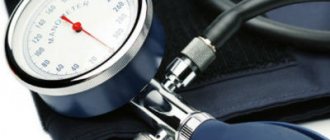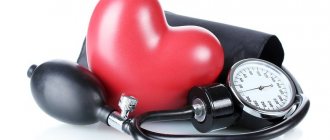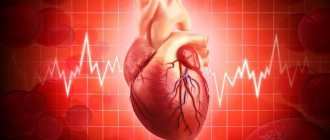Hypertension is an increase in blood pressure from 140/90 mmHg, which manifests itself regularly in a person and requires taking medications. If we talk about isolated systolic hypertension, then this form of arterial hypertension occurs mainly in elderly people over 60 years of age. In this case, only an increase in systolic pressure is observed, diastolic pressure remains normal - below 90 mmHg.
If we talk about the criteria for the disease, then until the mid-90s it was determined that the diagnosis of isolated systolic hypertension is established if the systolic pressure reaches 160 mmHg. But already in 1999, WHO determined that this indicator should be reduced to 140 mmHg.
Depending on the indicators of systolic blood pressure, three degrees of the disease are distinguished:
- 1st degree – 140-159 mmHg;
- 2nd degree – 160-179 mmHg;
- 3rd degree – 180 mmHg.
Causes of ISH
If we talk about the causes of ISH, then old age is not one of them, although we cannot exclude the fact that age-related changes in the body still affect the course of the disease, the features of its development and manifestations. The main causes include neurohormonal dysfunction and hemodynamic factors. It is worth noting that the severity of isolated systolic hypertension in no way depends on atherosclerosis, which is very often diagnosed in older people.
You can also identify additional factors that can provoke the development of ISH:
- abuse of fatty and too salty foods;
- insufficient amount of minerals in the body - potassium, magnesium;
- excess weight, leading to disturbances in the functioning of blood vessels;
- low physical activity, which helps reduce vascular tone;
- stress – constant being in a state of emotional tension has a detrimental effect on the functioning of the heart and blood vessels;
- diseases such as diabetes, liver problems.
Reasons for development
In the vast majority of cases, ISAH is diagnosed in elderly patients. Hypertension in them is a natural result of age-related (atherosclerotic) changes.
As the body ages, the aorta and large arteries become stiff due to the deposition of connective tissue fibers and calcium. They cannot adequately respond to pressure changes in different phases of the cardiac cycle. In this case, spastic processes predominate, and the ability to produce and respond to vasodilating factors weakens.
Conditions that contribute to the onset of the disease also include:
- decreased sensitivity of blood pressure analyzers (baroreceptors) in the vascular wall;
- drop in blood flow in the renal arteries, brain, muscles;
- low number and weak reactivity of type 2 beta-adrenergic receptors, responsible for vasodilation;
- myocardial hypertrophy of the left half of the heart;
- increased volume of tissue fluid (edema);
- reduced filtration capacity of the kidneys, glomerulosclerosis;
- high renin activity (increases blood pressure) and low kinin, kallikrein (dilate arteries);
- burdened heredity.
Myocardial hypertrophy can cause systolic hypertension
How is ISG developing?
In older people, there is a significant decrease in the elasticity of the arteries. In addition, processes of deposition of glycosaminoglycans, as well as calcium, elastin and collagen, occur. This significantly reduces the ability of blood vessels to respond correctly to pressure surges, in particular, its increase. In addition to problems with blood pressure, older people experience changes in the functioning of the kidneys and cardiovascular system, and decreased cerebral circulation.
By the age of 50, there is an increase in the volume of the atria, sclerosis of the glomeruli of the kidneys, and a decrease in the production of endothelium-dependent relaxation factors. It is also worth noting that the appearance of ISH largely depends on the genetic disposition of the patient.
There are primary and secondary forms of the disease. If we talk about the primary form of arterial hypertension, then there are no other diseases that provoke its appearance. As for the secondary form, it is often provoked by an increase in the volume of the heart and can occur with atrioventricular block, anemia, and some other diseases.
ISOLATED SYSTOLIC HYPERTENSION IN THE ELDERLY: PATHOPHYSIOLOGY, DIAGNOSIS AND TREATMENT
Isolated systolic hypertension (ISH) is diagnosed when systolic arterial blood pressure (SBP) is і 160 mm at.al. Hg and diastolic blood pressure (DBP) is < 90 mm et.al. Hg. ISH prevalence in the elderly population (60-85 years old) is between 10% and 20%. Primary and secondary ISH must be distinguished. Diagnosis of ISH is based on a few arterial pressure measurements obtained from repeated examinations. Diagnosis of false hypertension is possible during this examinations and Osier test for its evaluation is recommended. ISH treatment has been shown to prevent cardiovascular complications, diminish stroke and myocardial incidence on 36% and 27%, respectively. Patient's age and accrnpanying disorders must be considered in drug therapy prescribing. ,First line' drugs recommended for the ISH therapy are thiazide diuretics, betablockers, prolonger calcium antagonists and angiotensin converting enzyme antagonists. Therapy must result in SBP diminishing to 140-160 mm et.al.Hg and can include two-stage scheme if necessary. Drug therapy with diuretics as well as beta-blockers (in case of cardiac conductivity disturbances) must be under heart rate and EGG control held. One drug in minimal doses is recommended as an initial therapy. When the effect is insufficient doses can be increased or drug from another class can be selected but combined therapy is preferable.
* G.G. Arabidae, professor, hon. activities Sciences of the Russian Federation, Head of the Department of Arterial Hypertension at the Institute of Cardiology named after. A.L. Myasnikov Cardiology Research Center of the Russian Academy of Medical Sciences. ** Gr.G. Arabidze, Ph.D. honey. Sciences, assistant at the Department of Internal Medicine No. 2, Faculty of Medicine, MMSI named after. ON THE. Semashko. prof. GG Arabdze MD, owned scientist of the Russian federation, head of the department of arterial hypertension, Miasnikov, Institute of cardiology, Cardiology research center, Russian academy of medical Sciences. Gr. G. Arabidze, candidate of medical Sciences, assistant of the department of Internal medicine No. 2, therapeutic faculty, Semashko Moscow Medical Stomatological Institutes.
AND
Isolated systolic hypertension (ISH) affects 10 to 20% of elderly people. The increased risk of cardiovascular disease among patients with hypertension compared with that of age-matched normotensive patients decreases with increasing age at which high blood pressure (BP) appears, but even in older patients, systolic hypertension, both isolated and combined with elevated diastolic blood pressure (DBP), remains an important prognostic factor for cardiovascular diseases and mortality from them. Moreover, the frequency of cardiovascular complications in the elderly is closely related only to systolic blood pressure (SBP) [1]. In this regard, the concept of ISH, as well as the issues of its prevalence, pathophysiology, diagnosis and treatment, which this article is devoted to, are of undoubted interest for practicing physicians.
THE CONCEPT OF ISH AND ITS PREVALENCE
ISH is arbitrarily defined as SBP greater than or equal to 160 mmHg. Art. with DBP less than 90 mm Hg. Patients aged 60-85 years are considered elderly. SBP increases until at least age 80, while DBP increases only until age 50, after which DBP either levels off or decreases slightly. These trends in SBP and DBP, observed in a number of studies, explain the increase in pulse pressure and the increase in the prevalence of ISH with age [2, 3]. The prevalence of ISH has been assessed in numerous studies, but diagnosis has been made using different methods. In most cases, BP was measured in the clinic, and in some studies - at home. The number of blood pressure measurements also varies: they were performed either at a time, during one examination, or during two or even three separate appointments. The prevalence of ISH in many studies was calculated using a DBP threshold of 90 mmHg, or both 90 mmHg and 95 mmHg. Art., and in a smaller number of studies - with DBP only 95 mm Hg. Art. These differences in methodology must be taken into account when comparing or summarizing the results of studies. The prevalence of ISH estimated from a meta-analysis of data from multiple studies using a second-order regression model adjusted for sample size was 2.8% for 30 years of age, 0.1% for 40 years of age, 0.8% for 50 years of age, 5% for 60 years, 12.6% for 70 years and 23.6% for 80 years. The prevalence in women was on average 43% higher than in men (p < 0.01) [1].
PATHOPHYSIOLOGY
Pulse pressure - the difference between SBP and DBP - is determined by the distensibility of the arterial vascular bed, the stroke volume of the heart and, to a lesser extent, the ejection rate from the left ventricle. Mean blood pressure, which is the average between SBP and DBP, depends on cardiac output and total peripheral resistance. ISH, by definition, is characterized by an increase in pulse pressure, but not necessarily an increase in mean blood pressure. It is necessary to distinguish between primary and secondary ISH. Secondary forms can be caused by an increase in cardiac output (for example, with thyrotoxicosis or anemia) or the superposition of direct and reflected pressure waves in systole (for example, with arteriosclerotic obliteration of the lower extremities) [1]. Primary ISH occurs when SBP in previously normotensive patients rises above 160 mmHg without any obvious cause. However, it is likely that in some cases ISH may occur in hypertensive patients with a pre-existing increase in SBP and DBP, if SBP remains unchanged or even increases, while DBP decreases [1]. The hemodynamic mechanisms of primary ISH in elderly people require further clarification. Available data indicate that the main cause of primary ISH in patients over the age of 50 years can be considered a decrease in the distensibility of the aorta and arteries, leading to a loss of their ability to dampen pressure pulsations in systole and diastole. Increased aortic and arterial stiffness in elderly patients with ISH is likely due to the aging process: older age is associated with loss of elasticity of arterial wall fibers and deposition of collagen, elastin, glycosaminoglycans and calcium. With age, when the number of beta-adrenergic receptors that mediate vasodilation decreases, vasoconstrictor tone in large arteries may increase [4]. Many histological changes that occur with age in the walls of blood vessels are similar to atherosclerotic ones. However, the role of atherosclerosis in the pathogenesis of ISH in the elderly remains controversial. Clinical practice shows that in many patients with severe forms of widespread atherosclerosis, SBP remains within normal limits. In contrast, in some populations with a low prevalence of atherosclerosis, SBP increases with age and develops ISH.
DIAGNOSTICS
The methods used to establish the diagnosis of ISH vary: 5 blood pressure measurements have been described during each of the two examinations; other investigators performed 6 BP measurements at 25-minute intervals per visit. Because BP variability increases with age, BP should be measured several times during repeated examinations to establish the diagnosis of ISH. If SBP exceeds 160 mm Hg. when DBP is below 90 mmHg, the diagnosis of ISH is made. When diagnosing ISH, it is necessary to keep in mind the possibility of identifying pseudohypertension, which is characterized by an increase in pressure in the measuring cuff during indirect measurement of blood pressure, while intra-arterial pressure values are within normal limits. Pseudohypertension is caused by increased stiffness of the brachial artery wall or surrounding tissue, requiring higher cuff pressure to compress the artery. Since the stiffness of the large arteries increases with age, pseudohypertension is much more common in older people [5, 6]. The Osler test is used to detect pseudohypertension [6]. The measuring cuff placed around the shoulder is inflated above systolic pressure, and the radial and brachial arteries are carefully palpated. If one of these arteries is clearly palpable despite the absence of pulsation during cuff inflation, the patient is Osler-positive, having falsely elevated SBP or DBP with a difference between the cuff and intra-arterial pressures of 10-30 mm Hg. The prevalence of a positive Osler test increases from 0% for those aged less than 50 years to 2% in the age group 50-69 years and to 5 and 26%, respectively, for 70- and 80-year-olds, and among patients with ISH (DBP less than 90 mm Hg .) it is 24%.
TREATMENT
Medical opinions differ on when and how to treat ISH in the elderly. Some researchers believe that treatment of patients with uncomplicated increases in SBP should be limited to regular monitoring only. The American Working Group on Hypertension in the Elderly considers non-drug treatment of patients with ISH to be advisable [7], mainly through diet and lifestyle changes. Non-drug therapy also includes standardized physical activity, autogenic training, muscle relaxation, electrosleep and physiological bioacoustic influences (music). However, many doctors strive to reduce the risk of cardiovascular complications and resort to drug therapy. The latter is definitely indicated in cases where SBP exceeds 220 mmHg. or have cardiovascular complications. The feasibility of drug treatment for elderly patients with ISH was finally proven in the completed SHEP study (USA). The final data were obtained from a study of 4736 patients over the age of 60 years (on average 72 years), suffering from ISH - SBP 160-219 mm Hg, DBP below 90 mm Hg. Art., who for 4.5 years received placebo-controlled therapy with a thiazide diuretic in small doses (chlorthalidone 12.5-25 mg/day), adding atenolol if necessary. The result of treatment was a reduction in the incidence of strokes and myocardial infarction by 36 and 27%, respectively [8]. When choosing drug treatment, the physician must take into account two main factors - the age of the patient and the hemodynamic mechanisms underlying ISH in the elderly. These factors must be taken into account, since in elderly patients, compared with middle-aged patients, certain antihypertensive drugs have a greater or lesser effect on blood pressure. Such differences in drug efficacy in the elderly may reflect increases in blood pressure variability and vasoconstrictor tone with age, pronounced baroreflex impairment and orthostatic hypotension in old age, as well as age-related changes in the pharmacokinetics of individual antihypertensive drugs [1]. Vasoactive drugs that reduce the smooth muscle tone of large arteries effectively increase their distensibility. This has been shown for calcium antagonists, angiotensin-converting enzyme inhibitors (ACEIs), nitrates, and beta-blockers with sympathomimetic activity such as panadol (Wisken). SBP in patients with ISH also decreases with a decrease in the volume of ejection from the left ventricle during each cardiac cycle. Diuretics, even when taken chronically, reduce both plasma volume and stroke volume, and this may explain their effectiveness in reducing SBP in elderly patients with ISH [1]. The greatest experience in the treatment of ISH in old age has been accumulated in relation to diuretics. Based on the above, for the treatment and secondary prevention of complications of ISH, first-line antihypertensive drugs are recommended, i.e., those that do not disrupt lipid, carbohydrate and purine metabolism during long-term use, do not retain fluid in the body, do not provoke “rebound” hypertension, and do not cause pathological orthostatic reaction that does not inhibit the activity of the central nervous system. First-line drugs include β-blockers, ACE inhibitors, calcium antagonists, and thiazide diuretics. The main representatives of these classes of drugs, as well as recommended doses and number of doses per day are given in table [9].
Drugs used to treat IS
| A drug | Dose, mg | Number of appointments per day |
| ACEI: | ||
| Captopril() capoten | 12,5-25-50 | 1-3 |
| Enapril (Renitec) | 5-20 | 1-2 |
| Cilazapril(inhibase) | 2,5-5 | 1 |
| Ramipril(tritace) | 2,5-5 | 1 |
| Calcium antagonists* | ||
| Nifedipine(adalat) | 10 | 3 |
| Isradipin(lomir) | 2,5-5 | 2 |
| Verapamil(isoptin) | 240 (1 tablet) | 1 |
| Amlodipine (norvasc) | 5-10 | 1 |
| Amlodipine (norvasc) | ||
| b-Adrenergic blockers: | 10 | 1-2 |
| Pindolol(wisken) | 50-100 | 1 |
| Atenolol (tenormin) | 10 | 1 |
| Bisoprol (concor) | 100 | 1 |
| Metoprolol (lopresol) | 100 | 1 |
| Diuretics: | ||
| Hypothiazide | 12,5-25 | Once in the morning every day or every other day |
| *Preferably long-acting | ||
The result of drug therapy should be a decrease in SBP to 140-160 mmHg. Art. while maintaining DBP at 70 mm Hg. Art. However, it must be remembered that with a high initial SBP, blood pressure should decrease in two stages, first by no more than 25% of the initial level, and then, if the patient’s condition allows (there is no dizziness, nausea, angina pectoris and other signs of transient disorders of cerebral and coronary circulation) , up to 140-160 mm Hg. [10]. The need for a two-stage reduction in blood pressure is due to the fact that in most cases, elderly patients with initially high SBP suffer from atherosclerosis of the extracranial and coronary arteries, and a sharp decrease in blood pressure can lead to impaired cerebral and coronary circulation. In old age, disruption of the conduction system of the heart is often observed. For this reason, in people over 60 years of age, when using beta-blockers, heart rate and ECG should be monitored. Special ECG monitoring is required if the patient is constantly taking diuretics. Treatment should begin with one drug in the minimum recommended doses. If the effect of monotherapy is insufficient, you can increase the dose or change the class of the drug. However, it is more rational to add a second drug. The following combinations of drugs are recommended: b-blocker + diuretic; ACEI + diuretic; ACEI + long-acting calcium antagonist. The ultimate goal of treatment of elderly patients with ISH is not the reduction of blood pressure itself, but the prevention of complications (often fatal) of elevated SBP and, consequently, prolongation of life, as well as improvement of its quality. The latter is achieved mainly by preventing cardiovascular complications of systolic hypertension, maintaining the physical, mental and psycho-emotional state of patients. The side effect of drug therapy should be minor.
Literature:
1 . Staessen J, Amery A, Fogard R. Isolated systolic hypertension in the elderly. J Hypertension 1990;8:393-405. 2. Kannel WB, Gordon T. Evaluation of cardiovascular risk in the elderly. Bull NY Acad Med 1978;54:573-91. 3. Staessen J, Bulpitt C, Fagard R, et al. Four urinary cations and blood pressure: a population study in two Belgian towns. Am J Epidemiol 1983; 117:676-87. 4. Shaken DD, Roth GS. Reduced betaadrenergic receptor concentrations in aging man. Nature 1977;267:855-8. 5. Spence JD, Sibbald WJ, Cape RD. Pseudohypertension in the elderly. Clin. Sci Mol Med 1978;55(suppl.4):399-402. 6. Meserii FH, Ventura HO, Amodeo C. Osier's maneuver and pseudohypertension. N Engl J Med 1985;312:1548-51. 7. The Working Group on Hypertension in the elderly: Statement on hypertension in the elderly. JAMA 1986;256:70-4. 8. SHEP Research Group: Prevention of Stroke by Antihypertensive Drug Treatment in Older Persons with Isolated Systolic hypertension. JAMA 1991,-265:3255-64. 9. Arabidze G.G. Treatment tactics for patients with mild arterial hypertension. Russian Medical Journal 1996;2:80-3. 10. Arabidze G.G., Katsnelson A.A., Bykov A.V., Balishanskaya T.I. Features of treatment of patients with severe and malignant arterial hypertension. Cardiology 1995; 10:28-33.
Symptoms to watch out for
If we talk about symptoms, it is worth noting that in some cases a person may not feel an increase in SBP at all and lead a normal lifestyle. And high pressure readings will be determined only at the time of its measurement. But not all ISH is asymptomatic. A person may experience severe headaches, dizziness, and pain in the heart area. An unsteady gait, deterioration of hearing and vision are also often added.
As is typical for isolated systolic hypertension, the increase in blood pressure may not last so long, and SBP levels will return to normal on their own. But very often hypertensive crises occur, which are accompanied by persistent symptoms and can cause disruptions in the functioning of the cardiovascular system, in some cases even leading to death.
That is why ISG should not be ignored. If you have this disease, you need to regularly visit the doctor, undergo effective treatment, and take preventive measures.
Diagnosis of the disease
Diagnostics consists of several basic methods, and only with a comprehensive examination can an accurate diagnosis be established. First of all, the doctor must collect anamnesis, measure the patient’s blood pressure and pulse. But one measurement will not be enough to make a conclusion, so the patient may be admitted to the hospital for monitoring of indicators or invited for a follow-up appointment in a few weeks.
Also, diagnostic methods that cannot be avoided in this case include electrocardiogram, echocardiography, Dopplerography and biochemical blood test. Based on a comprehensive examination, an accurate diagnosis can already be established, which will help select effective treatment.
Features of treatment
If we talk about treatment, it is first of all started using non-drug methods of therapy. This is monitoring the patient’s diet, excluding fatty and salty foods from the diet; controlling a person’s weight if he is overweight (if possible, you need to get rid of extra pounds); moderate physical activity, which will help strengthen the heart and blood vessels, improve blood circulation; rejection of bad habits; relaxation with music.
Important! As for medications, only the doctor selects them, taking into account the hemodynamic mechanisms and age of the patient.
Typically, drug treatment consists of taking medications such as:
- diuretics are medications that help lower blood pressure, reduce the stroke volume of the heart, and reduce the likelihood of death due to a sharp increase in blood pressure. Diuretics also improve the distensibility of arteries;
- adrenergic blockers – protect against cerebrovascular complications;
- calcium antagonists – improve the elasticity of the arteries, reducing systolic pressure;
- ACE inhibitors – enhance the effect of calcium antagonists.
Practical recommendations for the treatment of hypertension. Part 1.
Differential criteria and indications for drug treatment of hypertension
Differential treatment of hypertension is focused not only on purely anamnestic and diagnostic criteria. It must take into account the patient’s willingness to follow medical recommendations (Compliance).
Mild and moderate hypertension, as a rule, does not affect the patient’s subjective well-being. It is precisely with this form of the disease, which causes almost no inconvenience to the patient, that a criterion such as tolerability receives central importance.
A patient with hypertension is more often willing to follow medical recommendations if the treatment measures do not disturb his normal well-being more than the disease itself.
Treatment of hypertension is more successful
- the more the doctor acts as a “trainer” during the necessary restructuring of lifestyle, who, together with the patient, develops therapeutically necessary techniques,
- the more the patient understands that changes in lifestyle and eating habits are beneficial to him,
- the less the patient perceives drug therapy as an additional burden and the less it is accompanied by unwanted side effects.
Patient dissatisfaction as an underappreciated aspect in hypertension treatment
In many patients, it is necessary to rearrange the initially prescribed antihypertensive therapy due to its insufficient tolerability. This was shown by a UK survey of 178 practitioners as part of the REACH study.
Physicians saw an average of 35 hypertensive patients per month in their private practice, including 2-3 new patients. During the treatment of patients, they had to change the antihypertensive drug on average 2 times a month, as well as supplement their chosen monotherapy with some combination drug 2 times a month.
Drugs were changed in 42% of cases. Combination - in 13% of cases due to unwanted side effects. It often takes quite a long time before a satisfactory antihypertensive therapy is selected; on average, three changes are required. In 18% of patients, doctors suggested insufficient compliance with the regimen prescribed by the doctor (Noncompliance). In 22% of cases, the reason for changing medications was due to unwanted side effects.
Another large retrospective study [16] of more than 37,000 patients with hypertension, also conducted in Britain, again revealed clear dissatisfaction among patients with the antihypertensive drugs offered to them.
6 months after the start of treatment, only 40-50% of patients continued to take the originally prescribed drug. The proportion of drug changes and treatment discontinuations was 50-60%, regardless of the class of substances used (diuretics, beta-blockers, ACE inhibitors, calcium antagonists). Moreover, the authors suggest that the reason for changing one class of drugs to another was mainly side effects.
Compliance criterion “tolerability”
With the advent of AII antagonists (for example, losartan, valsartan), doctors have received a new class of substances in the treatment of hypertension, allowing highly specific inhibition of the action of angiotensin II. An important positive point for practical use is the excellent tolerability of these drugs, since a patient who has not previously noticed his high blood pressure should feel no worse during therapy than before.
Compliance criterion “single dose”
Antihypertensive agents with a half-life of 6-9 hours and a guaranteed antihypertensive effect for 24 hours after administration of a single dose are suitable for use once a day. Working patients, as well as multimorbid patients, receive such advantages with a single dosage as no need to remember to take medications at work and during the day, replacing several with one tablet, etc.
In fixed combinations of antihypertensive drugs, for example, an ACE inhibitor and a diuretic, the pharmacological feasibility of a single dose must be ensured by the fact that both components must correspond in half-life.
The treatment regimen for mild, moderate, severe and malignant hypertension [1, 8, 10, 21] is presented in Figure 1.
Figure 1. Scheme of diagnosis and therapy for hypertension of varying severity (Modified from Stimpel, M.: Arterielle Hypertonie - Differentialdiagnose und Therapie, de Gruyter, Berlin, New York, 1990, [21]).
Moderate (mild) hypertension
Moderate hypertension is diagnosed when diastolic blood pressure is between 90 and 104 mmHg. If within 3-6 months it is not possible to reduce diastolic blood pressure despite general measures, you need to resort to drug treatment if the following factors are present:
- systolic pressure above 160 mm Hg.
- presence of cardiovascular diseases such as left ventricular hypertrophy, heart failure or coronary artery disease
- cerebrovascular diseases, cerebral infarction, transient ischemic attacks
- renal disease with elevated serum creatinine greater than 1.4 mg/dL, proteinuria or hematuria
- diabetes
- low-density lipoprotein cholesterol > 200 mm/dl
- low levels of high-density lipoprotein cholesterol: men < 35 mm/dl, women < 45 mm/dl
- high incidence of stroke, myocardial infarction or unexpected death from cardiac arrest in the family.
Moderate hypertension
Diastolic blood pressure indicators are between 105 and 114 mm Hg. If these indicators are confirmed by control pressure measurements over several days, then drug therapy is indicated along with general measures.
Severe and malignant hypertension
For severe hypertension with diastolic blood pressure above 115 mm Hg. It is also necessary to immediately begin drug treatment, as with malignant hypertension.
Serious clinical pictures for malignant hypertension are:
- diastolic blood pressure more than 120 mm Hg.
- hypertensive retinopathy with bleeding, exudates and/or swelling of the papillae
- progressive renal failure.
Isolated systolic hypertension
Isolated systolic hypertension, which is especially common in elderly patients, is characterized by systolic blood pressure above 160 mmHg. and diastolic blood pressure below 90 mmHg.
Along with general measures, drug treatment should be carried out if
- systolic blood pressure is more than 160 mm Hg.
- when systolic blood pressure is more than 140 mm Hg. there are limited complications or other risk factors.
Note: Treatment of elderly and senile patients with hypertension should be carried out carefully and drugs should be administered gradually and slowly, and systolic blood pressure, as a rule, should not fall below 140 mm Hg. In persons over 80 years of age, the indications for drug treatment are especially strict.
Hypertension and hypertensive crises in children and adolescents
Hypertension
To date, there have been few studies specifically devoted to the treatment of hypertension in children and adolescents. Basically, therapeutic measures correspond to therapy in adults.
Just in childhood, every effort should be made to completely exhaust all possibilities of general therapeutic measures and avoid long-term drug therapy. The following borderline indicators are used for prescribing drugs:
| Age | Upper limit |
| 2-5 years | 130/80 mmHg |
| 6-11 years | 135/85 mm Hg. |
| >12 years | 140/90 mmHg |
Indications for pharmacotherapy are available only with a very obvious and prolonged increase in blood pressure. First of all, in case of insulin-dependent diabetes mellitus (type I) and renal hypertension, one should strive to normalize blood pressure (at least to 95 mmHg) in order to avoid deterioration of renal function caused by hypertension.
Not all antihypertensive drugs have been sufficiently tested in pediatrics, but there are the following differential therapeutic provisions:
- The greatest experience is with the use of beta blockers in children and adolescents. At the same time, in some cases, the ability to work and play sports is impaired, so many children have to give up playing various sports.
- If there is retention of sodium chloride and fluid in the body, diuretics should be used first.
- Arterial hypertension in young patients with type I diabetes should be treated with ACE inhibitors.
Note: Due to progressive physical development in childhood, it is necessary to correlate the dosage of medications with weight, body weight and body surface area (Table 1).
Table 1. Dosage of antihypertensive drugs in the treatment of chronic hypertension* in childhood.
| A drug | Dosage (mg/kg per day) | Interval between doses (in hours) |
| 1.Diuretics | ||
| Hydrochlorothiazide | 0,5-1 | 24 |
| Chlorthalidone | 0,5-2 | 24-48 |
| Furosemide** | 1-5 | 8-12 |
| 2. Beta blockers | ||
| Propranolol | 1-5 | 8-12 |
| Atenolol*** | 1-2 | 24 |
| Metoprolol | 1-5 | 8-12 |
| 3. Antisympathomimetic drugs | ||
| Clonidine | 0,005-0,03 | 8-12 |
| 4. Postsynaptic alpha receptor blockers | ||
| Prazosin | 0,02-0,5 | 6-8 |
| 5. Vasodilators | ||
| Dihydralazine | 1-5 | 8-12 |
| Minoxidil | 0,01-0,5 | 12 |
| 6. Calcium antagonists | ||
| Nifedipine (retarded form) | 0,5-2 | 8-12 |
| Nitrendipine | 0,5-1 | 12-24 |
| Verapamil | 3-7 | 8-12 |
| 7. Conversion enzyme inhibitors | ||
| Captopril*** | 0,5-3,0 | 8-12 |
| For newborns and babies | 0,1-0,5 (1,0) | 8-12 |
* The choice of antihypertensive drugs is presented based on the results of scientific research. For adolescents, the same doses are indicated as for adults.
**Only for renal failure
***Dose reduction for progressive renal failure
Monitoring of blood pressure measurements is provided until normal blood counts are achieved at intervals of 1-2 weeks, and later every 4-12 weeks [7, 12, 13].
Hypertensive crisis
If, along with increased blood pressure, there are signs of hypertensive encephalopathy and pulmonary edema, then a hypertensive crisis is diagnosed. In this case, prompt use of pharmacotherapy by a family doctor or pediatrician and immediate hospitalization are necessary. For hypertensive crises in childhood, oral administration of nefidipine has worked well (see Table 2). For severe tachycardia, slow intravenous administration of clonidine is indicated [7, 13].
Hypertension in old and senile age
Even more than for children, in the treatment of older people suffering from high blood pressure, general therapeutic measures are the basis of antihypertensive therapy. However, with age, it becomes increasingly difficult to change habits that patients have adhered to throughout their lives, in particular, giving up certain favorite foods.
It is for this reason that drug therapy is justified in old age. An increase in blood pressure over 160 mm Hg. (systolic) or 95 mm Hg. (diastolic) is considered an indication for drug treatment also in patients over 65 years of age. Today we should assume that antihypertensive therapy increases life expectancy in patients over 60 (Fig. 2).
To date, we have no evidence of an improvement in life expectancy in patients over 80 years of age with antihypertensive therapy. But in this age group, careful pharmacotherapy may also be indicated in order to effectively treat comorbidities such as heart failure or angina symptoms due to coronary artery disease.
In principle, all antihypertensive drugs are used in the same way as in patients with hypertension at a younger age. There is no known antihypertensive drug that, solely because of the patient's age, cannot be used in the older age group.
For drug therapy of high blood pressure in older people compared to younger people, there are specific recommendations:
- The pressure should be reduced carefully and slowly over weeks or months, since an increased tendency to orthostatic disorders, impaired autoregulation of cerebral blood flow, reduced renal blood flow and a tendency to depression are quite common in elderly and old people. Therefore, it is recommended to start treatment with low doses of active substances and, if the effect is insufficient, only gradually increase the dose of the single drug or switch to low-dose combinations.
- In order not to overload old people and to ensure compliance with the prescribed regimen on their part, it is necessary to prescribe the simplest possible treatment regimen. Preferred medications are in a single daily dosage.
- It should be borne in mind that older people suffering from high blood pressure often suffer from many concomitant diseases. Therefore, you need to specifically monitor interactions with other drugs.
- Regular monitoring of blood pressure should also be carried out in a standing position. If it turns out that the blood pressure in a standing position is clearly lower than in a sitting position, then the dosage of an antihypertensive drug should be calculated depending on the pressure readings in a standing position. In no case should the orthostatic drop in blood pressure exceed 30 mm Hg. Antihypertensive drugs that lead to orthostatic pressure reduction are not intended for the treatment of elderly patients.
- Very often, elderly and senile patients do not report symptoms of intolerance to the drug, so the doctor must purposefully ask the patient and his relatives about unwanted side effects of therapy.
- Depending on the antihypertensive agent used, monitoring of laboratory parameters, primarily potassium, creatinine and glucose in the blood serum, is indicated.
- If side effects or disturbances in the patient’s general condition develop during pharmacotherapy, then drug therapy should be changed or discontinued.
Hypertension during pregnancy and lactation
The greatest danger during pregnancy is the development of eclampsia. The mortality rate for this complication is 5%, the mortality rate for unborn children is 20%. Maternal hypertension is fraught with danger to the fetus, which consists of growth retardation, as well as perinatal or intrauterine death.
Treatment of hypertension during pregnancy is as follows:
- General measures, especially a gentle regime of physical activity, avoidance of any tension and bed rest (if necessary in a hospital).
- Oral hypertensive therapy.
- For threatened and confirmed eclampsia, parenteral therapy, sedation, anticonvulsant treatment, albumin replacement therapy.
- If necessary, termination of pregnancy/induction of labor.
Controlled studies indicate that an improvement in fetal prognosis is only achievable if antihypertensive therapy is administered early in pregnancy. The essential goals are the prevention or attenuation of preeclampsia, as well as the prevention of intercurrent crisis-like increases in blood pressure.
Already with blood pressure readings of 140/90 mm Hg. you should consider prescribing drug therapy. An absolute indication for pharmacotherapy is systolic blood pressure above 160/170 mmHg. and diastolic - above 100-110 mm Hg. You should always try to reduce these indicators with as few doses of drugs as possible.
When treating hypertension in pregnant patients, the antihypertensive drugs of choice are highly selective beta-I receptor blockers, since they do not increase uterine tone and do not interfere with possibly necessary tocolytic treatment with beta-II stimulants.
Note: Because newborns of mothers treated with beta blockers prior to delivery may exhibit a transient, mild decrease in heart rate or hypotension, these infants should be closely monitored in the first days after birth.
There is extensive experience in the use of methyldopa in the treatment of pregnant women. Early initiation of long-term therapy with these drugs has been shown to avoid maternal eclampsia and improve the prognosis for the fetus.
Note: When methyldopa therapy was started at 14-20 weeks of pregnancy, the newborns had a reduced head volume. However, long-term observations up to 7 years did not show any impairment of neurological functions or intellectual development.
Both beta-I blockers and methyldopa pass into mother's milk in women treated with these substances, but the amount of substances transferred to the infant during breastfeeding is so small that pharmacological effects can not be expected and there is no fear of continuing this antihypertensive therapy into the mother's milk. postpartum period.
Other antihypertensive drugs are either contraindicated during pregnancy and lactation, or sufficient experience has not yet been accumulated in their use in this situation. Monitoring of outpatients treated requires blood pressure monitoring every 1-2 weeks. In addition, the patient should monitor her weight daily and measure and record her blood pressure several times a day [24].
Treatment of gestosis
In case of threatening or manifested eclampsia, it is necessary to immediately reduce blood pressure. In this case, it is better to administer intravenously antihypertensive drugs with a well-controlled effect; dihydralazine and urapidil are primarily suitable. The following aspects have practical significance in the treatment of threatened or manifested eclampsia:
- In these cases, intensive medical monitoring in the clinic is always required.
- If convulsions have already occurred, the following emergency treatment should be administered before transporting the patient to the hospital: dihydralazine (6.26 mg IV) or urapidil (12.5 mg IV) and diazepam (5-10 mg) for sedation mg i.v.). An alternative to diazepam can be magnesium sulfate for convulsions at a dosage of 1-3 g intramuscularly or for the prevention of convulsions and contractions at a dosage of 2-4 g intramuscularly.
- It is always necessary to quickly decide whether the pregnancy can be continued or whether labor must be induced once the mother’s condition has stabilized.
- The only possible causal therapy for gestosis is to prematurely induce delivery [6, 12, 23].
Hypertension in patients with concomitant diseases
When choosing a suitable antihypertensive drug, you should never think schematically in this case; you always need to select it individually. Along with the severity of hypertension and the age of the patient, it is necessary to take into account what kind of concomitant diseases he has [3, 5, 9, 11, 15, 18, 22].
The most important differential therapeutic aspects for various concomitant diseases are summarized in Table 3. The following explanations can be given to them.
Diabetes
There is no absolute benefit of any specific antihypertensive agent for all forms of diabetes mellitus. However, when choosing a drug, one should take into account the possible effect on metabolic status, insulin therapy, late diabetic complications and other concomitant diseases.
Diabetes type I
Drug therapy should be initiated in these mostly fairly young patients with an ACE inhibitor or calcium antagonist. Beta blockers should be prescribed with extreme restraint, as they mask the lack of sugar (symptom: delusional ideas).
Diuretics in patients with type I diabetes can be used only in cases of obvious renal failure (creatinine > 2.0 mg/dL) or when combination therapy is necessary. If monotherapy does not reduce blood pressure sufficiently, combinations of two or even three drugs can be used.
Type II diabetes
For young patients with relatively normal weight, the recommendations are the same as for patients with type I diabetes.
In patients over 65 years of age with type II diabetes, there is still no data that clearly favors any class of antihypertensive drugs. The choice of possible classes of diuretics, beta-I blockers, ACE inhibitors, calcium antagonists and postsynaptic alpha-I blockers is made in accordance with concomitant diseases (see Table 4). Table 5 summarizes the possible adverse events associated with therapy with these classes of drugs and the necessary monitoring measures.
If there is a persistent increase in blood pressure with monotherapy, combination therapy can also be used.
Kidney failure
In principle, all classes of antihypertensive drugs can be used to treat hypertension in patients with renal failure. However, it must be taken into account that the dose of all these primarily renal-excreted antihypertensive drugs must correspond to the renal filtration and secretory functions of the patients. This can be determined by determining serum creatinine concentration and creatinine clearance.
Diuretics are standard therapy for hypertensive patients with renal failure. When serum creatinine is above 2.0 mg/dL, thiazides in monotherapy are not effective enough and should be replaced with diuretics that also act in the loop of Henl (loop diuretics). Potassium-sparing diuretics are generally contraindicated in patients with limited renal function with serum creatinine above 2.0 mg/dL due to the possible development of hyperkalemia.
Patients with renal failure and severe hypertension are recommended to be referred for treatment to a specialized hospital.
Cardiovascular comorbidities (ischemic heart disease, heart failure, myocardial infarction, left ventricular hypertrophy)
In many studies, ACE inhibitors, beta blockers, calcium antagonists and central sympathomimetics have been shown to be effective agents for reducing left ventricular mass, with ACE inhibitors achieving qualitatively better results. In contrast, diuretics lead to a decrease in heart size without reducing wall thickness. Vasodilators are ineffective for regression of left ventricular hypertrophy.
In case of coronary artery disease or myocardial infarction, it is recommended to use beta blockers, predominantly beta-I-selective without sympathomimetic activity, the beneficial effects of which on cardiovascular complications have been proven. Also, ACE inhibitors in heart failure and after myocardial infarction have shown their effectiveness in reducing cardiovascular complications.
Calcium antagonists are particularly effective in treating hypertension in patients with stable angina.
Respiratory diseases
Hypertensive patients with concomitant obstructive airway disease can generally be treated safely with all antihypertensive agents except beta-receptor blockers. When treated with beta-blockers, due to blockade of adrenergic beta-II receptors in the airways, massive bronchial obstruction may develop in patients with obstructive pulmonary diseases.
Due to their potential beneficial effects on obstructive pulmonary processes, calcium antagonists and alpha-1 blockers, along with ACE inhibitors, are considered the treatment of choice for the treatment of hypertension in these patients.
Treatment of hypertensive emergencies
A hypertensive crisis occurs when blood pressure continuously rises to 250/140 mmHg over a period of several minutes to several hours. and higher. A sudden increase in pressure is accompanied by vascular complications such as hypertensive encephalopathy, pulmonary edema, angina pectoris or dissecting aortic aneurysms.
Note: With apoplectic stroke, a reactive increase in blood pressure is often observed, followed by spontaneous normalization within several hours. Therefore, a general decrease in pressure during a stroke that has just occurred is not indicated.
If the above effects do not occur, then oral administration of an antihypertensive drug in the usual dosage is sufficient.
However, if the first complications appear, the patient is in a life-threatening condition and requires immediate therapeutic intervention and hospitalization. At the same time, a quick and effective reduction in pressure has an absolute advantage over further diagnostic measures. When your blood pressure drops, keep the following in mind:
- blood pressure should be reduced not lower than the initial values, if they are known; lower limit - 160/90 mm Hg.
- Usually, reducing the pressure to 180/95 mm Hg is sufficient.
- a rapid and sharp decrease in pressure can lead to transient ischemic attacks, thrombotic vascular occlusion, acute coronary insufficiency, or even blindness!
Remedies available to the family doctor: oral administration of 5 mg nifedipine or nitrendipine in a rapidly absorbed form - possible repetition - possible side effects: headache or oral administration of 1-2 mg nitroglycerin - repetition possible - possible side effects: headache.
If this is not enough, then alternatively (the same as first aid) use: 0.075 mg clonidine slowly IV - repetition is possible - possible side effects: sedation, bradycardia or 25 mg urapidil IV - repetition is possible - possible side effects: headache, dizziness, palpitations.
Further emergency measures should be carried out in the hospital [5, 11, 22, 23].
Table 2. Dosage and method of use of drugs for acute decrease in blood pressure in childhood.
| On practice: | Dosage (mg/kg) | Introduction |
| Nifedipine | 0,3-0,5 | under the tongue, orally |
| Clonidine | 0,003-0,006 | slow i.v. |
| Urapidil | 1-4 | the first hours slowly intravenously, maintenance dose 0.5-2 mg/kg per hour |
| Dihydralazine | 0,2-0,8 | IV |
| Sodium nitroprusside | 0.5-10.0 mcg/kg per minute | infusion, used only in intensive care units |
Table 3. Differential therapeutic criteria in patients with hypertension with concomitant diseases or additional criteria.
| Elderly and senile patients (>65 years) | Diuretics and calcium antagonists are preferred |
| Left ventricular hypertrophy | ACE inhibitors, beta blockers, calcium antagonists and central sympathomimetics are preferred |
| IHD | beta blockers and calcium antagonists are preferred |
| Previous myocardial infarction | ACE inhibitors and beta blockers are preferred |
| Heart failure | ACE inhibitors and diuretics are preferred |
| Kidney failure | When serum creatinine is above 2.0 mg/dL, a loop diuretic is usually administered. Potassium-sparing diuretics, especially in combination with ACE inhibitors, can lead to hyperkalemia. Be aware of the possibility of delayed elimination of some hypertensive drugs (dosage adjustment is necessary). |
| Obstructive airway disorders | Calcium antagonists, ACE inhibitors and alpha-I blockers are preferred. Beta blockers are contraindicated. |
| Diabetes | In young patients with type I and II diabetes, low-dose ACE inhibitors, relatively beta-I-selective blockers and calcium antagonists are preferred. In elderly patients with type II diabetes, target therapy based on comorbidities. For diabetes, use non-selective beta blockers with caution. |
| Gout/hyperuricemia | Avoid prescribing diuretics |
| Dyslipoproteinemia | There are still no clinical studies that would substantiate any specific therapeutic recommendations. ACE inhibitors and calcium antagonists have almost no effect. Diuretics and beta blockers have a rather unfavorable effect depending on the dose, while alpha-I blockers have a rather beneficial effect. The clinical significance of these changes is unclear. |
| Pregnancy | If necessary, use beta-I-selective blockers or alpha-methyldopa, which have been proven safe for fetal development. |
| Benign prostatic hypertrophy | Alpha I blockers |
Table 4. Therapeutic recommendations for patients with type II diabetes according to age and comorbidities
| Elderly patients (>65 years): Diuretics and calcium antagonists are preferred. |
| IHD: beta-I blockers and calcium antagonists are preferred. |
| Heart failure: ACE inhibitors and diuretics are preferred. |
| Gout: refrain from prescribing diuretics. |
| Obstructive airway disorders: calcium antagonists, ACE inhibitors and postsynaptic alpha blockers are preferred; all beta blockers are contraindicated. |
| Renal failure: if serum creatinine is above 2.0 mg/dL, loop diuretics are prescribed; Potassium-sparing diuretics may cause hyperkalemia and are contraindicated. It should be remembered that some antihypertensive drugs are released slowly (for example, atenolol, nadolol, sotalol, almost all ACE inhibitors). |
| Pregnancy: use beta-I-selective blockers and alpha-methyldopa, which have been proven safe for fetal development. ACE inhibitors and calcium antagonists of the dihydropyridine (nifedipine) series are contraindicated. |
| Hyperlipidemia: There are still no clinical studies that offer specific therapeutic recommendations. However, it should be borne in mind that lipid levels may increase when using diuretics, depending on the dose. With beta-I-selective blockers a slight increase is observed, with calcium antagonists and ACE inhibitors almost no changes are observed, with postsynaptic alpha-I blockers even a slight decrease is expected; the clinical significance of these changes is still unclear. |
| Arterial occlusion/obstruction: There are also no clinical studies large enough to provide specific therapeutic recommendations. When using beta-I-selective beta blockers, the individual clinical course of the disease should be monitored more closely; non-selective beta blockers are not recommended. |
Table 5. Possible side effects of various classes of substances in the treatment of hypertension in patients with diabetes
| ACE inhibitors: begin therapy cautiously; they may reduce microalbuminuria; the risk of hypotension and hyperkalemia should be taken into account; with renal artery stenosis can lead to limitation of kidney function. |
| Calcium antagonists: renal function must be monitored. |
| Cardioselective beta blockers in low dosages: in higher doses there is a risk of undetected hypoglycemia; lowering high-density lipoprotein cholesterol levels: impotence. |
| Alpha blockers: risk of orthostatic hypotension, impotence and depression. |
| Diuretics in low dosages: at higher dosages, the possibility of hypokalemia, elevated blood sugar and lipids, and impotence should be taken into account. |
Abstract on: “Current recommendations for quality treatment of hypertension. - German League of Physicians against Hypertension, Union of Hessian Health Physicians, German Society for the Fight against Hypertension. - Second edition. - Frankfurt am Main, 1999.









